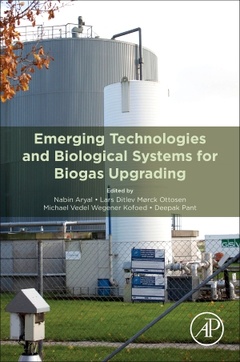Description
Emerging Technologies and Biological Systems for Biogas Upgrading
Coordinators: Aryal Nabin, Morck Ottosen Lars Ditlev, Wegener Kofoed Michael Vedel, Pant Deepak
Language: English
Subject for Emerging Technologies and Biological Systems for Biogas...:
Keywords
?Absorption; Adsorbents; Adsorption; Amine; Anaerobic digestion; Anaerobic microbiology; BES; Biocathode; Bioelectrochemical systems; Biogas; Biogas purification; Biogas sweetening; Biogas upgradation; Biogas upgrading; Biogas upgrading technologies; Biological methanation; Biological treatment; Biomethanation; Biomethane; Biomethane upgrading; CO2; CO2 conversion; CO2 removal efficiency; CO2 sequestration; CSTR; Chemical absorption; Condensation; Cooling; Cryogenic techniques; Desulfurization; Economic insight; Electrolysis; Electrolyzers; Electromethanogens; Electron donor; Energy policy; Fuel cell; Gas grid; Gas separation; Gas solubility; Gas-liquid mass transfer; H2S; Hot potassium carbonate; Hybrid cryogenic systems; Hydrogenotrophic methanogenesis; Innovative cryogenic approaches; LCA; Membrane separation; Membrane technology; Methanation; Methane slip; Microalgae; Microbial fuel cell (MFC); Microbial interspecies electron transfer; Monoethanolamine; Organic waste; Oxidation; Oxidation-reduction kinetics; Packed bed; Photobioreactor; Photosynthetic; Policy support; Power-to-gas; Power-to-gas technology; Pressure swing adsorption; Reactor design; Reactor designs; Reduction; Renewable energy; Self-sustainable systems; Stripping; Techno-economic analysis; Transport fuel; Trickling bed reactors; Upgrading; Volatile methylsiloxanes; Volatile organic silicon compounds; Waste biorefinery; Water scrubbing
530 p. · 15x22.8 cm · Paperback
Description
/li>Contents
/li>Readership
/li>Biography
/li>Comment
/li>
Part I: Introduction1. Status of biogas production, biogas upgrading: A global Scenario
Part II: Physiochemical upgrading systems 2. Chemical Absorption - amine absorption/stripping technology for biogas upgrading3. Water scrubber for biogas upgrading developments and innovations4. Factor affecting CO2 and CH4 separation during biogas upgrading in a water scrubbing process5. Recent development on pressure swing adsorption for biomethane production6. Membrane based technology for methane separation from biogas7. Cryogenic techniques - an innovative approach for biogas upgrading8. Power-to-gas for methanation9. Electrochemical approach for biogas upgrading10. Siloxanes removal from biogas and emerging biological techniques
Part III: Biological upgrading systems 11. Hydrogen sulfide removal for biogas upgrading and emerging bioprocess (H2S) 12. Biological upgrading of biogas through CO2 conversion to CH413. Bioelectrochemical system of biogas upgrading and methane enrichment14. Photosynthetic biogas upgrading: an attractive biological technology for biogas upgrading
Part IV: Policy implications for biogas upgrading 15. Biogas upgrading and life cycle assessment of different biogas upgrading technologies16. Anaerobic digestion, techno-economic implications and governmental policies for the promotion of biomethantion technologies17. Large scale biogas upgrading plants: Future prospective and technical challenges
Researchers, engineers, and graduate students in the field of biogas production and utilization technologies, including waste-to-energy
Lars Ditlev Mørck Ottosen is Professor in Environmental Biotechnology with focus on energy and environmental technologies. He is also Head of the Biological and Chemical Engineering Department at Aarhus University, Denmark. He has extended R&D experience from more than a decade in the industry, and as university professor in projects that combine research and industrial technology development. Prof. Ottosen has more than 100 publications. In addition to technology R&D, He is dedicated to education, and played a key role in developing new BSc and MSc educational program in Biological and Chemical Engineering at Aarhus University.
Michael Vedel Wegener Kofoed is Project Director and Research Group Leader of Microbial Conversion Technologies in the Biological and Chemical Engineering Section at the Department of Engineering of Aarhus University, Denmark. With expertise in bioengineering and industrial microbiology for solving societal and industrial challenges, his current focus is methanation for pr
- Explores all major technologies for biogas upgrading through physiochemical, biological, and electrochemical processes
- Discusses CO2, H2S, and siloxane removal techniques
- Provides a systematical approach to discuss technologies, including challenges to gas–liquid mass transfer, life cycle assessment, technoeconomic implications, upscaling and systems integration
These books may interest you

Biogas Technology in Nigeria 61.25 €



